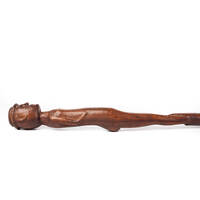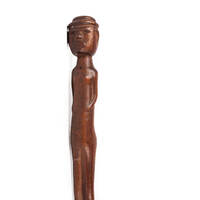Metadata
Staff
[ Source of title : FHYA using spreadsheet prepared by Nessa Leibhammer for SAHRIS ]
Object
JAG 1992-11-29
Creative Commons License: CC BY-NC-ND https://creativecommons.org/licenses/by-nc-nd/4.0/
Description [Source - Debra Pryor for FHYA, 2022, using spreadsheet created by Nessa Leibhammer for the South African Heritage Resources Information System (SAHRIS), from JAG materials in 2015: Object description: Shaft finial is a standing man wearing a round flat hat. Snall arms are held slightly curved and flat onto torso. Eyes are small metal pieces (nails?) Object form type: staff; Object material type: wood; Technique: Carving; Colours: Brown; Dimension comment: 85,5 x 4 x 4; Object age: 19th to early 20th century; Production place: Southern Africa; Cultural association: ; Place of use: Southern Africa; Provenance: .]
Attributions and conjectures [Source - Nessa Leibhammer for FHYA, 2017: Comments on classification: In his 'A Preliminary Survey of the Bantu Tribes of South Africa', Union of South Africa, Department of Native Affairs, Ethnological Publications, Vol. 5, Pretoria, Government Printer, (1935): 7, 70-83, national government ethnologist, Nicholas Van Warmelo did not use the term "North Nguni". He grouped people living both north and south of the Thukela, under one umbrella term, "Natal Nguni", based on linguistic affinity. His classification was adapted by the ethnology curator, Margaret Shaw, in her 1958 "System of Cataloguing Ethnographic Material in Museums" which determined that items from the region were to be classified as "Natal Nguni: Zulu and others (not differentiated)." According to art historian, Anitra Nettleton, the classificatory system used by art galleries and museum shifted from Shaw's model to the one where "Natal Nguni" fell away and was replaced by "North/Northern Nguni" for KwaZulu-Natal and Swaziland because scholars found it difficult to distinguish items from adjacent areas, or emigrant people from those from the KZN region. Scholars working with the JAG materials used broad ethno-linguistic categories (Zulu, Xhosa, Tsonga, Shona, Sotho, Tswana) to identify the makers/users of the objects, all of which came to JAG without much by way of provenance, and identification was based on factors such as object type, materials, formal composition, style and surface patterning (emails A. Nettleton to N. Leibhammer, 25 and 28 November 2014).]
| Event Actor | Event Type | Event Date | Event Description |
|---|---|---|---|
| Five Hundred Year Archive (FHYA) | Online curation | 2022- | Digital image supplied by Nessa Leibhammer |
| South African Heritage Resources Agency (SAHRA) | Digitisation | c.2015 | Digital image made for The South African Heritage Resources Agency (SAHRA). Metadata compiled by JAG's ex-curator Nessa Leibhammer for the South African Heritage Resources Agency (SAHRIS) database |
| Johannesburg Art Gallery (JAG) | Custody | 1992- | JAG purchased this object from Mordechai Brodie |
| Anglo American Johannesburg Centenary Trust | Donation | [19-?] | |
| Anglo American Johannesburg Centenary Trust | Purchase | [19-?] | |
| Udo Horstmann | Collection | [19-?] | |
| Unacknowledged | Making | 19th to early 20th century |
If you have difficulty accessing the objects, use these links.




Contributions